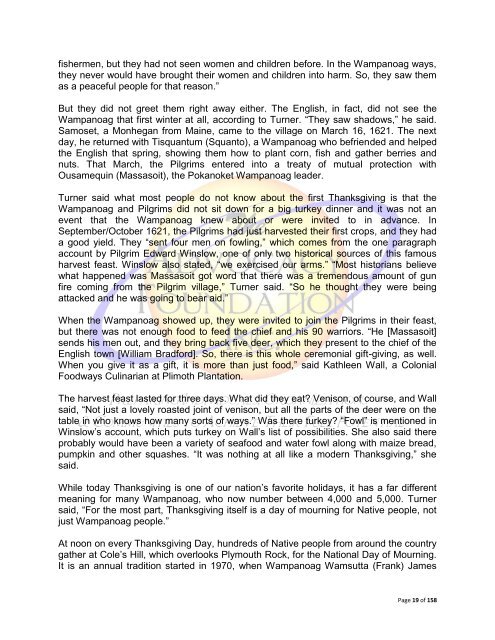Native American Youth In The Juvenile Justice System
Native American Youth In The Juvenile Justice System
Native American Youth In The Juvenile Justice System
You also want an ePaper? Increase the reach of your titles
YUMPU automatically turns print PDFs into web optimized ePapers that Google loves.
fishermen, but they had not seen women and children before. <strong>In</strong> the Wampanoag ways,<br />
they never would have brought their women and children into harm. So, they saw them<br />
as a peaceful people for that reason.”<br />
But they did not greet them right away either. <strong>The</strong> English, in fact, did not see the<br />
Wampanoag that first winter at all, according to Turner. “<strong>The</strong>y saw shadows,” he said.<br />
Samoset, a Monhegan from Maine, came to the village on March 16, 1621. <strong>The</strong> next<br />
day, he returned with Tisquantum (Squanto), a Wampanoag who befriended and helped<br />
the English that spring, showing them how to plant corn, fish and gather berries and<br />
nuts. That March, the Pilgrims entered into a treaty of mutual protection with<br />
Ousamequin (Massasoit), the Pokanoket Wampanoag leader.<br />
Turner said what most people do not know about the first Thanksgiving is that the<br />
Wampanoag and Pilgrims did not sit down for a big turkey dinner and it was not an<br />
event that the Wampanoag knew about or were invited to in advance. <strong>In</strong><br />
September/October 1621, the Pilgrims had just harvested their first crops, and they had<br />
a good yield. <strong>The</strong>y “sent four men on fowling,” which comes from the one paragraph<br />
account by Pilgrim Edward Winslow, one of only two historical sources of this famous<br />
harvest feast. Winslow also stated, “we exercised our arms.” “Most historians believe<br />
what happened was Massasoit got word that there was a tremendous amount of gun<br />
fire coming from the Pilgrim village,” Turner said. “So he thought they were being<br />
attacked and he was going to bear aid.”<br />
When the Wampanoag showed up, they were invited to join the Pilgrims in their feast,<br />
but there was not enough food to feed the chief and his 90 warriors. “He [Massasoit]<br />
sends his men out, and they bring back five deer, which they present to the chief of the<br />
English town [William Bradford]. So, there is this whole ceremonial gift-giving, as well.<br />
When you give it as a gift, it is more than just food,” said Kathleen Wall, a Colonial<br />
Foodways Culinarian at Plimoth Plantation.<br />
<strong>The</strong> harvest feast lasted for three days. What did they eat? Venison, of course, and Wall<br />
said, “Not just a lovely roasted joint of venison, but all the parts of the deer were on the<br />
table in who knows how many sorts of ways.” Was there turkey? “Fowl” is mentioned in<br />
Winslow’s account, which puts turkey on Wall’s list of possibilities. She also said there<br />
probably would have been a variety of seafood and water fowl along with maize bread,<br />
pumpkin and other squashes. “It was nothing at all like a modern Thanksgiving,” she<br />
said.<br />
While today Thanksgiving is one of our nation’s favorite holidays, it has a far different<br />
meaning for many Wampanoag, who now number between 4,000 and 5,000. Turner<br />
said, “For the most part, Thanksgiving itself is a day of mourning for <strong>Native</strong> people, not<br />
just Wampanoag people.”<br />
At noon on every Thanksgiving Day, hundreds of <strong>Native</strong> people from around the country<br />
gather at Cole’s Hill, which overlooks Plymouth Rock, for the National Day of Mourning.<br />
It is an annual tradition started in 1970, when Wampanoag Wamsutta (Frank) James<br />
Page 19 of 158

















